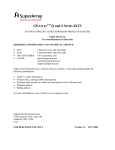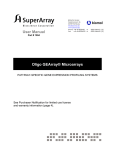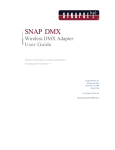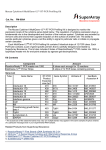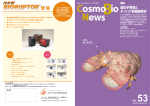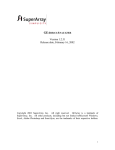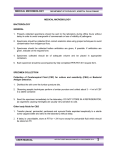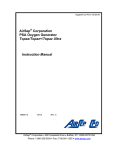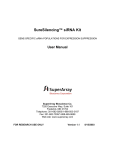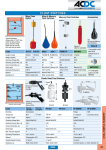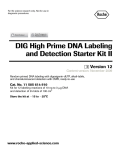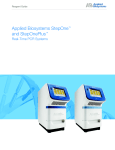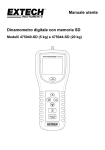Download GEArrayTM Q Series KIT
Transcript
GEArrayTM Q Series KIT A PATHWAY-SPECIFIC GENE EXPRESSION PROFILING SYSTEM USER MANUAL For chemiluminescent detection ORDERING INFORMATION AND TECHNICAL SERVICE • • • • TEL: FAX: ON-LINE ORDER: E-MAIL: 1-888-503-3187, 301-682-9200 1-888-465-9859, 301-682-7300 www.superarray.com [email protected] [email protected] [email protected] Orders may be placed by fax, e-mail or from our website. Each order should include the following information: • • • • • Caller’s contact information Product name, catalog number and quantity Purchase order number or credit card information (Visa or MasterCard) Shipping address Billing address For more information, visit us at http://www.superarray.com Important note to customers outside the USA: All international array kits are shipped without dry ice. The temperature sensitive reagent (Buffer BN) must be prepared when you receive the kit. DTT and dNTPs are not included in this package. SuperArray Bioscience Corp. 7320 Executive Way, Suite 101 Frederick, MD 21704 USA FOR RESEARCH USE ONLY Version 6.1 1/31/2003 GEArray TM Q Series User Manual 2 CONTENTS I. Introduction 3 Materials Provided 5 III. Additional Materials Required 6 IV. GEArrayTM Q Series Assay Protocol A. Probe Synthesis 1. RT-Labeling Enzyme 2. TrueLabeling-RT Enzyme 3. AmpoLabeling-LPR Kit B. Hybridization C. Chemiluminescent Detection D. Image and Data Analysis 7 8 10 12 14 16 17 Troubleshooting Guide 18 II. V. LIMITED PRODUCT WARRANTY This product is intended for research purposes only and is not intended for drug or diagnostic purposes or for human use. This warranty limits our liability to replace this product in the event the product fails to perform due to any manufacturing defect. SuperArray Bioscience Corporation makes no other warranties of any kind, expressed or implied, including without limitation, warranties of merchantability or fitness for a particular purpose. SuperArray Bioscience Corporation shall not be liable for any direct, indirect, consequential or incidental damages arising out of the use, the results of use or the inability to use this product. NOTICE TO PURCHASER THE PURCHASE OF GEARRAY PRODUCTS INCLUDES A LIMITED, NONEXCLUSIVE LICENSE TO USE THE MEMBRANES FOR RESEARCH USE ONLY. THIS LICENSE DOES NOT GRANT RIGHTS TO USE THE MEMBRANES FOR REPRODUCTION OF GEARRAY FILTERS, TO MODIFY GEARRAY FILTERS FOR RESALE OR TO USE GEARRAY TO MANUFACTURE COMMERCIAL PRODUCTS WITHOUT WRITTEN APPROVAL OF SUPERARRAY BIOSCIENCE CORPORATION. NO OTHER LICENSE, EXPRESSED, IMPLIED OR BY ESTOPPEL, IS GRANTED. U.S. PATENTS MAY COVER CERTAIN ISOLATED DNA SEQUENCES INCLUDED ON THE GEARRAY. PRESENTLY, IT IS NOT CLEAR UNDER U.S. LAWS WHETHER COMMERCIAL USERS MUST OBTAIN LICENSES FROM THE OWNERS OF THE RIGHTS TO THESE U.S. PATENTS BEFORE USING GEARRAY. GEArray TM Q Series User Manual 3 I. INTRODUCTION The advancement of nucleic acid array technology has made it possible to analyze the expression of multiple genes in a single experiment. However, most commercial gene expression array products, designed to include as many genes as possible, produce vast amounts of data that is overwhelming and difficult to interpret. In addition, the cost of detection equipment and bioinformatics software is often prohibitive. Based on our popular first generation of pathway-specific gene expression arrays, the GEArrayTM Q Series provides additional features that allow researchers to characterize gene expression associated with a specific biological pathway in a more comprehensive and costeffective manner. The GEArrayTM Q Series is a result of combining superior array design with state-of-the-art arraying and detection technologies. It is easy to use, sensitive, economical and accessible for routine use in every research laboratory. The GEArrayTM Q Series cDNA expression array contains up to 96 cDNA fragments from genes associated with a specific biological pathway. Gene-specific cDNA fragments are printed on a 3.8 x 4.8 cm nylon membrane with an advanced non-contact printing technology. Each cDNA fragment is printed with our tetra-spot format, which provides a signal in an easily identifiable pattern. The catalog number and a unique bar-coded serial number are printed on the reverse side of the membrane for easy tracking and documentation. The GEArrayTM Q Series is designed for one-time use only. Each array membrane is packaged in a disposable hybridization tube. Multiple arrays are included in each kit, allowing for a parallel and comparative study of multiple samples. Finally, the GEArray analysis software is available free of charge for GEArray users and can be downloaded from our website at www.superarray.com. Features of the GEArrayTM Q series • • • • • • • • Easy to use with minimal hands-on time Comprehensive collection of genes in a specific pathway Proprietary arraying/detection technology offers high sensitivity Tetra-spot format for reliable signal detection and identification Available for both radioactive and non-radioactive detection No special equipment required Cost-effective for routine use Free software for data analysis and reporting GEArray TM Q Series User Manual Figure 1: Overview of the GEArrayTM Q series procedure 4 GEArray TM Q Series User Manual 5 II. MATERIALS PROVIDED: GEArray Q Series GEArray Q Series membranes in disposable tubes GEArray Q Series Quick Protocol and grid card BOX 1 cDNA Probe Synthesis Buffer A (GEAprimer mix)* Buffer BN (5X GEAlabeling Buffer) (USA Customers Only) OR 10X RT Buffer (International Customers)** RNase-free H2O Buffer C (10X Stop Solution) Buffer D (10X Denaturing Solution) Buffer E (2X Neutralization Solution) Hybridization and Detection GEAhyb Hybridization Solution Trial Standard 2 4 1 1 Bulk 12 1 20 µl 60 µl 100 µl 1 ml 100 µl 100 µl 1 ml 20 µl 60 µl 100 µl 1 ml 100 µl 100 µl 1 ml 60 µl 60 µl 100 µl 1 ml 100 µl 100 µl 1 ml 50 ml 50 ml 50 ml 30 ml 20 µl 100 ml 100 ml 5 ml 30 ml 20 µl 100 ml 100 ml 5 ml 30 ml 20 µl 100 ml 100 ml 16 ml BOX 2 GEAblocking Solution Q AP-Streptavidin 5X Buffer F (5X Washing Buffer) Buffer G (AP Assay Buffer) CDP-Star Substrate * If using the AmpoLabeling-LPR Kit to synthesize probe, make sure to use the Buffer AF included with the labeling kit instead of the Buffer A included with the array kit. **Note for international customers: When you first open BOX 1, the Nonrad-GEArray Labeling Kit, you need to convert the 10 X RT buffer to 5X Nonrad-GEA Labeling Buffer (Buffer BN). To make 100 µL of Buffer BN, combine 50 µL of 10 X RT Buffer, 1 µL 1 M DTT, and 50 µL dNTP mix (5 mM each dATP, dCTP, and dGTP, and 0.5 mM dTTP). Mix well. Store the entire box at –20 °C. GEArray TM Q Series User Manual 6 III. ADDITIONAL MATERIALS REQUIRED: The GEArrayAnalyzer software can be downloaded from www.superarray.com free of charge. If you prefer, please call us, and a CD can be sent to you (Cat. No. GA001). The following labeling kits for cDNA Probe Synthesis are sold separately by SuperArray: Product RT-Labeling Enzyme TrueLabeling-RT Enzyme AmpoLabeling-LPR Kit Cat. No. L-01 L-02 L-03N Reasons for Use Page Experiments optimized using previous Q Series kits. 8 Reduces high background and false positive signals. 10 Amplifies signal intensities for limiting RNA or message. 12 NOTE: The AmpoLabeling-LPR Kit contains an array-specific reagent. Please indicate the GEArray catalog number as well as catalog number L-03N when ordering. For your convenience, step-by-step instructions are provided for each protocol on the pages listed above. If you already have RNase Inhibitor (Promega, Cat No. N2511) and MMLV Reverse Transcriptase (Promega Cat. No. M1701 or Applied Biosystems, Cat. No. N808-0018), follow the procedure for the RT protocol. The above table also describes the advantages of using each of our labeling kits. Note to international customers: The AmpoLabeling-LPR Kit can be shipped internationally; however, one temperature-sensitive reagent is excluded and must be ordered separately. (See the Protocol included in the labeling kit or on Page 12 of this manual.) At this time, the RTLabeling Enzyme and the TrueLabeling-RT Enzyme Kits may not be available in all international territories. Please contact your distributor for more information. You may also order and use your own MMLV Reverse Transcriptase and RNase Inhibitor as described above, and follow the labeling protocol for the RT enzyme. The following reagents are required but are not supplied by SuperArray: cDNA Probe Synthesis: Biotin-16-dUTP (Roche, Cat. No. 1-093-070). Hybridization and Washing: Sheared Salmon Sperm DNA (Invitrogen/Life Technologies, Cat. No. 15632-011). 20X SSC: Dissolve 175.3 g NaCl and 88.2 g sodium citrate dehydrate into 900 ml H2O. Adjust pH to 7.0 with 1M HCl. Dilute to 1 L with H2O. Store at room temperature. 20% SDS: Dissolve 200 g sodium dodecyl sulfate in 1 L H2O. Heat to 65 °C if necessary to dissolve. Store at room temperature. You will also need the following laboratory equipment: Thermal cycler or at least two water baths or hot blocks Hybridization oven and cylinders or other means to agitate at high temperature X-ray film (Kodak X-OMAT) and Scanner OR CCD Camera and its software GEArray TM Q Series User Manual IV. 7 GEArrayTM Q SERIES ASSAY PROTOCOL Notes: RNA Preparation Total RNA prepared using commercially available kits is suitable for GEArrayTM Q Series analysis. Total RNA prepared by Trizol Reagent (Invitrogen/Life Technologies, Cat. No. 15596-018), RNeasy mini kits (Qiagen, Cat. No. 74104) or RNAqueous (Ambion, Cat. No. 1911, 1912, or 1913) gives good results. Total RNA should be dissolved in RNase-Free H2O. It is not necessary to prepare poly(A)+ RNA; however, the quality of the RNA is crucial for the success of the assay. It is also not necessary to treat RNA samples with DNase. In fact, DNase should not be used if you are synthesizing probe with the AmpoLabeling-LPR Kit. It is important to check the absorbance reading of your RNA sample not only to determine the concentration but also to assess its purity from proteins and free nucleotides. The ratio of the absorbance reading at 260 nm to the reading at 280 nm should be greater than 1.8. In addition and if possible, the integrity of the RNA preparation should be checked by ethidium bromide-stained agarose gel electrophoresis. A quality RNA preparation should yield two sharp bands representing the 28S and the 18S ribosomal RNA (rRNA). The intensity of the 28S (slower mobility) band should also be roughly twice that of the 18S (greater mobility) band. A smearing of either two bands or a decrease in the intensity ratio indicates RNA degradation. Sometimes even intact RNA does not guarantee good array results because RNA samples may also be contaminated with enzyme inhibitors that can reduce labeling efficiency. We recommend that first-time users of our array kits check their probe labeling before hybridization. (See the Troubleshooting Guide.) Notes: Description Of Membrane Appearance Each GEArray Q Series nylon membrane array is supplied in a disposable hybridization tube. One side of the membrane is printed with the cDNAs in the tetra-spot format visible initially as blue dots. These dots will fade by the end of the procedure, and this side of the membrane will then appear blank. This side of the membrane should always face the inside of the hybridization tube, and should face your film or CCD camera during image acquisition. On the reverse side of the membrane, every array has a unique serial number and barcode to allow tracking of the array during the course of your experiment. Array side: Arrayed with cDNA spots. Faces the inside of the hybridization tube. Reverse side: Printed with information. Faces the outside of the hybridization tube. Figure 2: The two sides of the GEArrayTM Q Series membrane Note: Wear gloves while performing all steps of this protocol. GEArray TM Q Series User Manual 8 A. Probe Synthesis: Synthesis of cDNA probes with Biotin-16-dUTP (Roche, Cat. No. 1-093-070) Note: If you plan to perform your hybridization immediately after probe synthesis, start the prehybridization (B, step 1) before continuing with this section. 1. GEArray RT-Labeling Enzyme (Catalog Number L-01) International customers: At this time, the RT-Labeling Enzyme Kit may not be available in all international territories. Please contact your distributor for more information. Note: You may also follow this protocol using other sources of RNase Inhibitor (Promega, Cat No. N2511) and MMLV reverse transcriptase (Promega Cat. No. M1701 or Applied Biosystems, Cat. No. N808-0018). Note: There is no need to treat total RNA with DNase. a. Prepare the Annealing Mixture: For each total RNA sample, combine the following in a sterile PCR tube: Total RNA Buffer A RNase-free H2O 1.0-5.0 µg 3 µl to adjust the final volume to 10 µl. Note: Buffer A is unique for each GEArrayTM Q Series kit. Please do not substitute Buffer A from other GEArrayTM Q Series kits. Check the Catalog Number on the tube before use. Mix the contents well but gently with a pipettor followed by brief centrifugation. Place the mixture in a pre-heated heat block or thermal cycler at 70 °C for 3 min. Cool to 42 °C and keep at that temperature for 2 min. Note: A pre-programmed PCR thermal cycler is recommended. b. Prepare the RT Cocktail: This mixture can be prepared while the Annealing Mixture is incubating at 70 °C. RT Cocktail 1 array 2 arrays 4 arrays Buffer BN 4 µl 8 µl 16 µl Biotin-16-dUTP 2 µl 4 µl 8 µl RNase-free H2O 2 µl 4 µl 8 µl RNase Inhibitor (RI) 1 µl 2 µl 4 µl Reverse Transcriptase (RE) 1 µl 2 µl 4 µl Final volume 10 µl 20 µl 40 µl Warm the RT Cocktail at 42 °C for 1 min before proceeding to the next step. GEArray TM Q Series User Manual 9 c. RT Reaction: For each array, transfer 10 µl of the pre-warmed RT Cocktail to the 10 µl Annealing Mixture. Mix well but gently with a pipettor. Continue incubation at 42 °C for 90 min. d. Denature the probe: Stop the RT Reaction by adding 2 µl of Buffer C. Add 2 µl of Buffer D to each RT Reaction now containing labeled cDNA probe. Incubate at 68 °C for 20 min. Add 25 µl of Buffer E and continue incubation at 68 °C for another 10 min. Note: Buffer E may precipitate when thawed at room temperature. We recommend warming Buffer E to 68 °C and vortexing before use. Alternatively, the cDNA probe can be denatured by heating at 94 °C for 5 min, and quickly chilling on ice. The cDNA probe is now ready for hybridization (B). Note: It is not necessary to remove unincorporated biotin-16-dUTP from the cDNA probe. The total labeling reaction mixture can be used for hybridization directly. Note: We highly recommend checking the probe for dUTP incorporation before setting up the hybridization. (See the Troubleshooting Guide at the end of the Manual for details.) GEArray TM Q Series User Manual 10 A. Probe Synthesis: Synthesis of cDNA probes with Biotin-16-dUTP (Roche, Cat. No. 1-093-070) Note: If you plan to perform your hybridization immediately after probe synthesis, start the prehybridization (B, step 1) before continuing with this section. 2. GEArray TrueLabeling-RT Enzyme (TL-RT) Protocol (Catalog Number L-02) International customers: At this time, the TrueLabeling-RT Enzyme Kit may not be available in all international territories. Please contact your distributor for more information. Note: There is no need to treat total RNA with DNase. a. Prepare the Annealing Mixture: For each total RNA sample, combine the following in a sterile PCR tube: Total RNA Buffer A RNase-free H2O 2.5–5.0 µg 3 µl to adjust the final volume to 10 µl. Note: Buffer A is unique for each GEArrayTM Q Series kit. Please do not substitute Buffer A from other GEArrayTM Q Series kits. Check the Catalog Number on the tube before use. Mix the contents gently with a pipettor followed by brief centrifugation. Place the mixture in a pre-heated heat block or thermal cycler at 70 °C for 3 min. Cool to 42 °C and keep at that temperature for 2 min. b. Prepare the RT Cocktail: This mixture can be prepared while the Annealing Mixture is incubating at 70 °C. RT Cocktail 1 array 2 arrays 4 arrays Buffer BN 4 µl 8 µl 16 µl Biotin-16-dUTP 2 µl 4 µl 8 µl RNase-free H2O 2 µl 4 µl 8 µl RNase Inhibitor (RI) 1 µl 2 µl 4 µl Reverse Transcriptase (AE) 1 µl 2 µl 4 µl Final Volume 10 µl 20 µl 40 µl Warm the RT Cocktail at 42 °C for 1 min before proceeding to the next step. GEArray TM Q Series User Manual 11 c. RT Reaction: For each array, transfer 10 µl of the pre-warmed RT Cocktail to the 10 µl Annealing Mixture. Mix well but gently with a pipettor and incubate at 42 °C for 90 min. d. Denature the probe: Stop the RT Reaction by adding 2 µl of Buffer C. Add 2 µl of Buffer D to each RT Reaction now containing labeled cDNA probe. Incubate at 68 °C for 20 min. Add 25 µl of Buffer E and continue incubation at 68 °C for another 10 min. Note: Buffer E may precipitate when thawed at room temperature. We recommend warming Buffer E to 68 °C and vortexing before use. Alternatively, the cDNA probe can be denatured by heating at 94 °C for 5 min, and quickly chilling on ice. The cDNA probe is now ready for hybridization (B). Note: It is not necessary to remove unincorporated biotin-16-dUTP from the cDNA probe. The total labeling reaction mixture can be used for hybridization directly. Note: We highly recommend checking the probe for dUTP incorporation before setting up the hybridization. (See the Troubleshooting Guide at the end of the Manual for details.) GEArray TM Q Series User Manual 12 A. Probe Synthesis: Synthesis of cDNA probes with Biotin-16-dUTP (Roche, Cat. No. 1-093-070) Note: If you plan to perform your hybridization immediately after probe synthesis, start the prehybridization (B, step 1) before continuing with this section. 3. GEArray AmpoLabeling-LPR Protocol (Catalog Number L-03N) NOTE: The AmpoLabeling-LPR Kit contains an array-specific reagent. Please indicate the GEArray catalog number as well as catalog number L-03N when ordering. International customers: The RE component below is not included with the kit. Please order MMLV reverse transcriptase (Promega Cat. No. M1701 or Applied Biosystems, Cat. No. N808-0018) and use in the place of RE. You also need to convert 10X RT Buffer to Buffer BN: Combine 50 µL of 10X RT Buffer, 1 µL 1 M DTT, and 50 µL dNTP mix (5 mM each dATP, dCTP, and dGTP, and 0.5 mM dTTP). Mix well. Store at –20 °C. Note: In order for LPR to work properly, your RNA samples must be free of fragmented genomic DNA. We do not recommend treating your sample with DNase because the fragmented genomic DNA may increase the background. Instead, take care to remove genomic DNA intact from your sample during your isolation protocol. RT Reaction: a. Prepare the Annealing Mixture: For each total RNA sample, combine the following into a sterile PCR tube: Total RNA* Buffer P RNase-free H2O 0.5-5.0 µg 1 µl to adjust the final volume to 10 µl. *We have successfully synthesized labeled probe with as little as 0.1 µg total RNA. Mix the contents gently with a pipettor followed by brief centrifugation. Place the mixture in a thermal cycler at 70 °C for 3 min. Cool to 37 °C and keep at that temperature for 10 min. b. Prepare the RT Cocktail: This mixture can be prepared while the Annealing Mixture is incubating at 37 °C. RT Cocktail 1 array 2 arrays 4 arrays Buffer BN 4 µl 8 µl 16 µl RNase-free H2O 4 µl 8 µl 16 µl RNase Inhibitor (RI) 1 µl 2 µl 4 µl Reverse Transcriptase (RE) 1 µl 2 µl 4 µl Final Volume 10 µl 20 µl 40 µl Warm the RT Cocktail at 37 °C for 1 min before proceeding to the next step. GEArray TM Q Series User Manual 13 c. RT Reaction For each array, transfer 10 µl of the RT Cocktail to the 10 µl Annealing Mixture. Mix well but gently with a pipettor and continue incubation at 37 °C for 25 min. Heat at 85 °C for 5 min to hydrolyze the RNA and to inactivate the reverse transcriptase. Hold the finished RT Reaction on ice until the next step. LPR Labeling Reaction: Note: The temperature should not exceed 85 °C at anytime during LPR. d. Prepare the LPR Cocktail: For each Q Series kit, mix the following in a sterile PCR tube: LPR Cocktail 1 array 2 arrays 4 arrays Buffer L 18 µl 36 µl 72 µl Buffer AF 9 µl 18 µl 36 µl Biotin-16-dUTP 2 µl 4 µl 8 µl DNA Polymerase (LE) 1 µl 2 µl 4 µl Final Volume 30 µl 60 µl 120 µl Note: Buffer AF is unique for each GEArrayTM Q Series kit. Please do not substitute Buffer AF meant for other GEArrayTM Q Series kits. Check the Catalog Number on the tube before use. Also, please do not use any source of Buffer A for LPR. e. Linear Polymerase Reaction (LPR): For each array, add 30 µl of the LPR Cocktail to each RT Reaction and mix well but gently with a pipettor. Program the thermal cycler for LPR as follows: 85 °C, 5 min; 30 cycles** of (85 °C, 1 min; 50 °C, 1 min; 72 °C, 1 min); then 72 °C, 5 min **The cycle number can be reduced when using larger amounts of total RNA and/or when specifically interested in more abundant messages. We do not recommend increasing the number of cycles. f. Immediately stop LPR by adding 5 µl of Buffer C and chilling on ice. g. Denature the probe: Denature the labeled cDNA probe by heating the tube containing the LPR at 94 °C for 2 min, and quickly chilling on ice. The cDNA probe is now ready for hybridization (B). Note: It is not necessary to remove unincorporated biotin-16-dUTP from the cDNA probe. The total labeling reaction mixture can be used for hybridization directly. Note: We highly recommend checking the probe for dUTP incorporation before setting up the hybridization. (See the Troubleshooting Guide at the end of the Manual for details.) GEArray TM Q Series User Manual 14 B. Hybridization: Note: To prevent leakage, always tighten the caps of both your hybridization cylinders (that come with your hybridization oven) and our hybridization tubes containing the arrays. Note: An O-ring is provided with the hybridization tube and should be placed around the end of the tube opposite the cap. The O-ring allows the tube to sit level inside your hybridization cylinder and insures that all volumes of solutions cover the membrane evenly. 1. Pre-hybridization: Note: This step can be performed during Probe Synthesis. Pre-wet the array membrane by adding roughly 5 ml of deionized water to the hybridization tube. Allow tube to sit inverted while preparing the GEAprehyb. Warm the GEAhyb Hybridization Solution to 60 °C and invert the bottle several times to allow complete dissolution of the buffer components. Heat the sheared salmon sperm DNA at 100 °C for 5 min and immediately chill on ice. Prepare GEAprehyb: Add the heat-denatured salmon sperm DNA to the pre-warmed GEAhyb Hybridization Solution to a final concentration of 100 µg/ml. You will need 3 ml of GEAprehyb for each array. Keep the GEAprehyb solution at 60 °C until needed. Discard the deionized water from the hybridization tube. Add 2 ml of the GEAprehyb solution, and vortex the tube gently for a few seconds. Be sure the cap of the tube is screwed on hand-tight. Place the tube inside your hybridization cylinder. Two GEArray Q series hybridization tubes will fit inside a standard hybridization cylinder (ID x L = 35 x 150 mm). Pre-hybridize in your hybridization oven at 60 °C for 1 to 2 hours with continuous agitation at 5 to 10 rpm. 2. Hybridization: Prepare GEAhyb: Add the entire volume of denatured cDNA probe to 0.75 ml of prewarmed GEAprehyb. Mix well, and keep the GEAhyb at 60 °C. Discard the GEAprehyb from the hybridization tube. Add the GEAhyb (containing probe) to the hybridization tube. Hybridize overnight at 60 °C with continuous agitation at 5 to 10 rpm. GEArray TM Q Series User Manual 15 3. Washing: Prepare excess: Wash Solution 1: 2X SSC, 1 % SDS (100 ml 20X SSC and 50 ml 20 % SDS per liter) Wash Solution 2: 0.1X SSC, 0.5 % SDS (5 ml 20X SSC and 25 ml 20% SDS per liter) You will need at least 10 ml of each per hybridization tube. Warm both to 60 °C. Pour the GEAhyb solution from the hybridization tube into a clean micro-centrifuge tube. Store at 4 °C until the end of the experiment in case another array needs to be probed. Wash the membrane twice with 5 ml Wash Solution 1 at 60 °C with 20 to 30 rpm agitation for 15 minutes each. Vortex the tube gently with each wash. Wash the membrane twice with 5 ml Wash Solution 2 at 60 °C with 20 to 30 rpm agitation for 15 minutes each. Vortex the tube gently with each wash. GEArray TM Q Series User Manual 16 C. Chemiluminescent Detection Note: All detection steps are performed at room temperature. Note: GEAblocking Solution Q and 5X Buffer F may cloud during storage at 4 °C. Warm the solutions to 37 °C and invert the bottles several times to allow any precipitate to completely dissolve. Allow the solutions to sit at room temperature until needed. 1. Blocking the Array: After discarding the last wash, immediately add 2 ml GEAblocking Solution Q. Incubate for 40 min with continuous agitation at 20 to 30 rpm. 2. Binding of alkaline phosphatase-conjugated streptavidin (AP): Prepare Binding Buffer: Dilute 5X Buffer F five-fold to prepare excess 1X Buffer F. Dilute AP 1:7,500 into 1X Buffer F. We suggest dispensing volumes of AP no smaller than 2 µl. You will also need 16 ml of 1X Buffer F per tube for washing (3). Discard the GEAblocking Solution Q from the tube. Add 2 ml Binding Buffer, and incubate for 10 min with continuous but gentle (5-10 rpm) agitation. 3. Washing: Wash the membrane four times with 4 ml 1X Buffer F for 5 min with gentle agitation. Vortex the tube gently after each addition of fresh 1X Buffer F. Rinse or wash twice with 3 ml Buffer G. 4. Detection: Add 1.0 ml CDP-Star chemiluminescent substrate to the hybridization tube. Incubate at room temperature for 2 to 5 min. Alternatively, place the GEArray Q Series membrane on a sheet of plastic wrap and drop the 1.0 ml of CDP-Star solution onto the membrane. Note: It is very important to have the membrane covered evenly with the substrate. Blot the membrane on a piece of filter paper to remove excess CDP-Star Solution. Place the membrane between two plastic sheets or into a small plastic zip-lock bag and smooth out any bubbles. GEArray TM Q Series User Manual 17 D. Image and Data Acquisition and Analysis: 1. Image Acquisition Note: Remember the blank side of the array should face your film or camera. Orient the array so that the bar code on the reverse side of the membrane is on the right and the name of the array on the reverse side is on the top as you face it. (See Figure 3.) Expose the membrane to X-ray film OR use a CCD camera and imaging station to acquire the image. We recommend obtaining multiple exposures for various times. Start with an initial exposure of 1-2 min on film and 5-10 min using a digital imaging system. The visualization of high abundance messages will require shorter exposures; lower abundance messages, longer exposures. If your CCD camera imaging software allows you visualize when the signals are saturated, obtain the longest exposure without saturating any of the signals. The CDP-Star substrate reaches peak light emission between 2-4 hr, and persists for several days. Therefore, there is ample time to collect the image, but it should be performed as soon as possible. If X-ray film is used to record the image, use a scanner to convert the image into a grayscale TIFF file. Be sure to save this file. If using a CCD camera to obtain the image, you may also save the image as a grayscale TIFF file. Alternatively, you may use the imaging station’s software to save the image and convert it into numerical data. 2. Data Acquisition If using a grayscale TIFF image, convert the image of tetra-spots into numerical data using the free ScanAlyze software developed by Dr. Michael Eisen and featured as a hyperlink on our website (www.superarray.com). The software saves the numerical data as a tabular file recognizable by Microsoft Excel. If using your imaging station’s software to convert the image into numerical data, be sure to collect data from the entire tetra-spot for each cDNA. Collect the data in the order outlined in Figure 3 (left to right, top to bottom) to insure that the order will match that of our gene lists. Save the raw data as a Microsoft Excel file. 3. Data Analysis SuperArray has free data analysis software, GEArray Analyzer, available on our website (www.superarray.com). GEArray Analyzer matches your raw data table with the gene list for the particular GEArray. It also provides you with a list of background subtraction and data normalization options. It generates data tables and other graphical reports, including bar charts, scatter plots and pseudo-color plots. Please refer to the GEArray Analyzer User Manual for more detailed instructions. Each GEArrayTM Q series membrane is spotted with a negative control of pUC18 DNA, blanks, and housekeeping genes, including β-actin, GAPDH, cyclophilin A and ribosomal protein L13a. All raw signal intensities should be corrected for background by subtracting the signal intensity of a negative control or blank. All signal intensities should also be normalized to that of a housekeeping gene. These corrected, normalized signals can then be used to estimate the relative abundance of particular transcripts. GEArray TM Q Series User Manual Reverse side has printed bar code on right side edge 18 Order in which numbered genes and resulting data are and should be placed Array side faces the detector Figure 3: Data extraction sequence for GEArray Q series V. TROUBLESHOOTING GUIDE AND FREQUENTLY ASKED QUESTIONS RNA quality is crucial to the success of the array. It is important to check your RNA quality. The ratio of the 260 nm and 280 nm absorbance readings should be greater than 1.8. Also, a good RNA prep should produce two sharp bands on an ethidium bromide-stained agarose gel, representing the 28S and the 18S ribosomal RNA (rRNA). The 28S band should be roughly 2 times more intense than the 18S band. A smearing of either of the two bands, a decrease in the 28S to 18S intensity ratio, or a ratio of A260/A280 less than 1.8 indicates degradation of the RNA sample. In which case, perform your RNA preparation again before proceeding with the array analysis. However, sometimes even intact RNA does not guarantee a good result because the RNA sample may still contain inhibitors that can reduce labeling efficiency. We also recommend that you check the probe labeling before starting the hybridization. (See below.) A. WEAK OR NO SIGNALS Other than the quality of RNA sample, the following factors may also impair your results. 1. Low RNA sample concentration. If the RNA sample is too dilute, it may not perform well in the assay. The RNA concentration should be at least 0.5 mg/ml. 2. Inhibited reverse transcriptase. a. Total RNA should be dissolved in RNase-free dH2O or TE Buffer (10mM TrisHCl, 1mM EDTA). Be sure that the EDTA concentration does not exceed 1 mM; a high EDTA concentration inhibits the reverse transcriptase. b. Solutions that contain SDS as well as unautoclaved DEPC water will inhibit the reverse transcriptase. c. If CsCl2 or LiCl were used in the process of total RNA purification, trace amounts of Cs2+ or Li+ will inhibit the reverse transcriptase. GEArray TM Q Series User Manual 19 3. Insufficient probe labeling. Many factors including the two mentioned above can result in inadequate labeling of the probe. We highly recommend checking biotinylated probe labeling efficiency in the following manner. a. Add 2 µl of the completed Probe Synthesis reaction to 38 µl of 1X agarose gel loading buffer (20-fold dilution). b. Perform 4-fold serial dilutions by mixing 3 µl aliquots of each successive dilution with 9 µl of 1X agarose gel loading buffer to yield 80-, 320-, 1280-, and 5120-fold dilutions. c. Separately spot 1 µl of each diluted sample onto a HyBond nylon membrane (e.g. Amersham Pharmacia, Cat. No. RPN303B). Allow the membrane to air-dry for at least 10 minutes. d. Follow the Chemiluminescent Detection protocol in the GEArray Original Series User Manual for Chemiluminescent Detection. If the total biotin-deoxyuridylate incorporation is detectable at dilutions of 1000 fold or higher, the probe should yield good array signals. 4. Improper washing in 0.1x SSC solution. Excessive washing of the membrane in high stringency buffer (0.1x SSC solution) may strip off the hybridized probes. Washing time should not exceed 15 minutes. 5. Loss of labeled probe during column purification. Column purification can result in a low yield of labeled probe. We recommend adding the complete Probe Synthesis reaction directly into the hybridization solution. 6. Improper hybridization temperature. Check the actual temperature inside your hybridization oven with a thermometer. The temperature reading on your hybridization oven could be several degrees off calibration. B. HIGH BACKGROUND Other than the quality of RNA sample, the following factors may cause high background: 1. Pre-hybridization step incomplete. Be sure to denature your sheared salmon sperm DNA completely before making your pre-hybridization solution. 2. Inaccurate AP-streptavidin dilution. Since the AP-streptavidin is dissolved in a glycerol containing solution, special caution should be taken when pipetting the small volume of AP-streptavidin. We suggest diluting no less than 2 µl of AP-streptavidin into 15 ml of buffer (a 1:7,500 dilution). The final working AP-streptavidin dilution can also be increased to 1:12,000. 3. Improper incubation time with AP-streptavidin. Incubation can be reduced to 10 min or less. 4. Improper washing temperature conditions. Be sure to use enough Wash Solution 2 during the low-stringency washing step. Also, be sure to wash the GEArrayTM Q series membrane at 60ºC with agitation at 20-30 rpm. 5. Biotin contamination in containers or buffers. Milk contains a high amount of biotin. Never use any lab ware that has been used for western blotting. GEArray TM Q Series User Manual 20 6. Improper membrane incubation. Always use enough solution to completely cover each membrane. Never let the membranes dry out at any stage in the procedure. 7. Over-exposure. Try multiple exposures for various times. 8. Too much total RNA. Reduce the amount of total RNA used for Probe Synthesis. C. How do I prevent leakage of the hybridization tube that you provide? Put the tube in a regular hybridization cylinder (not provided). Close the cap of this cylinder and our hybridization tube cap hand-tight. An airtight cylinder can prevent the hybridization tube from leaking. We also suggest using DuraSeal, a sealing film from Diversified Biotech (Cat No. DS1-150 etc.). It seals the hybridization tubes very well, which is especially important for users of the Radioactive Detection method. D. Why do I get a hybridization signal on the negative control (pUC18) spot? A positive signal on the pUC18 negative control occurs most often when the RNA sample used for Probe Synthesis came from a plasmid transfected cell line. Although we use a gene specific primer mix for the labeling reaction, a small amount of plasmid RNA may still be converted to cDNA and labeled by non-specific priming in the RT reaction. Therefore, it is possible to get hybridization signals on pUC18 spots. E. The MMLV reverse transcriptase from Promega is 200 Units/µl. Do I need to dilute it to 50 Units/µl before use? No. Using 5 to 10-fold more reverse transcriptase during Probe Synthesis will not impair your results. However, the concentration of the reverse transcriptase should not be below 50 Units/µl. F. Can I use a reverse transcriptase from another vendor? Yes, the GEArray labeling buffer works well with reverse transcriptases from many other sources. Make sure that the concentration of your reverse transcriptase is 50 Units/µl or higher. G. How do I prepare buffer BN? Buffer BN is included in the kit, which is shipped on dry ice. However, if improperly stored, if you need to make more for a particular reason, or if you are an international customer, use the following recipe. For every 50 µl 10X RT Buffer, add 1 µl of 1M DTT and 50 µl of 10X dNTP mix (5 mM dATP, 5 mM dCTP, 5 mM dGTP, and 500 µM dTTP). Mix well. Store the prepared buffer BN at –20 °C. If you have additional questions, please check our website (www.superarray.com) for a more complete listing of Frequently Asked Questions (FAQs), or call our technical support representatives at 1-888-503-3187 or 301-682-9200. CDP-Star is a registered trademark of Applera Corporation or its subsidiaries in the US and certain other countries.




















